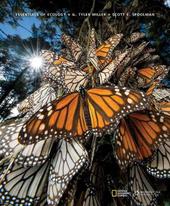
|
Essentials of Ecology
Paperback / softback
Main Details
| Title |
Essentials of Ecology
|
| Authors and Contributors |
By (author) G. Miller
|
|
By (author) G. Miller
|
|
By (author) Scott Spoolman
|
|
By (author) Scott Spoolman
|
| Physical Properties |
| Format:Paperback / softback | | Pages:400 | | Dimensions(mm): Height 277,Width 232 |
|
| Category/Genre | Ecological science |
|---|
| ISBN/Barcode |
9781285197265
|
| Classifications | Dewey:577 |
|---|
| Audience | | Tertiary Education (US: College) | |
|---|
| Edition |
7th edition
|
|
Publishing Details |
| Publisher |
Cengage Learning, Inc
|
| Imprint |
Brooks/Cole
|
| Publication Date |
1 January 2014 |
| Publication Country |
United States
|
Description
'Inspiring people to care about the planet.' In the new edition of ESSENTIALS OF ECOLOGY, authors Tyler Miller and Scott Spoolman have partnered with the National Geographic Society to develop a text designed to equip students with the inspiration and knowledge they need to make a difference solving today's environmental issues. Exclusive content highlights important work of National Geographic Explorers, and features over 100 new photos, maps, and illustrations that bring course concepts to life. Using sustainability as the integrating theme, ESSENTIALS OF ECOLOGY 7e, covers scientific principles and concepts, ecosystems, evolution, biodiversity, population ecology, and more. In addition to the integration of new and engaging National Geographic content, every chapter has been thoroughly updated and 6 new Core Case Studies offer current examples of environmental problems and scenarios for potential solutions. The concept-centered approach used in the text transforms complex environmental topics and issues into key concepts that students will understand and remember. Overall, by framing the concepts with goals for more sustainable lifestyles and human communities, students see how promising the future can be and their important role in shaping it.
Author Biography
G. Tyler Miller has written 62 textbooks for introductory courses in environmental science, basic ecology, energy, and environmental chemistry. Since 1975, Miller's books have been the most widely used textbooks for environmental science in the United States and throughout the world. They have been used by almost three million students and have been translated into eight languages. Miller has a professional background in chemistry, physics, and ecology. He has a PhD from the University of Virginia and has received two honorary doctoral degrees for his contributions to environmental education. He taught college for 20 years, developed one of the nation's first environmental studies programs, and developed an innovative interdisciplinary undergraduate science program before deciding to write environmental science textbooks full time in 1975. Currently, he is the president of Earth Education and Research, which is devoted to improving environmental education. Scott Spoolman is a writer and textbook editor with more than 30 years of experience in educational publishing. He has worked with Tyler Miller since 2003 as a contributing author on editions of LIVING IN THE ENVIRONMENT, ENVIRONMENTAL SCIENCE, and SUSTAINING THE EARTH. With Norman Myers, he also coauthored ENVIRONMENTAL ISSUES AND SOLUTIONS: A MODULAR APPROACH. Spoolman holds a master's degree in science journalism from the University of Minnesota. He has authored numerous articles in the fields of science, environmental engineering, politics, and business. He worked as an acquisitions editor on a series of college forestry textbooks. He has also worked as a consulting editor in the development of over 70 college and high school textbooks in fields of the natural and social sciences. In his free time, he enjoys exploring the forests and waters of his native Wisconsin along with his family- his wife, environmental educator Gail Martinelli, and his children, Will and Katie.
ReviewsPART I: HUMANS AND SUSTAINABILITY: AN OVERVIEW. 1. Environmental Problems, Their Causes, and Sustainability. PART II: SCIENCE, ECOLOGICAL PRINCIPLES, AND SUSTAINABILITY. 2. Science, Matter, Energy, and Systems. 3. Ecosystems: What Are They and How Do They Work? 4. Biodiversity and Evolution. 5. Biodiversity, Species Interactions, and Population Control. 6. The Human Population and Its Impact. 7. Climate and Biodiversity. 8. Aquatic Biodiversity. PART III: SUSTAINING BIODIVERSITY. 9. Sustaining Biodiversity: The Species Approach. 10. Sustaining Terrestrial Biodiversity: The Ecosystem Approach. 11. Sustaining Aquatic Biodiversity.
|